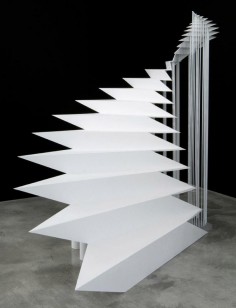SARAH DORNNER
source: themovingmuseum
Sarah Dornner’s sculptures, drawings, videos and photos employ repetitive patterns and isometric lines often associated with a domestic setting, but assembled in a way that frustrates the space in which they are placed. “My work re-imagines a domestic space that is not bound by rules or limitations, but one that has opened up to new possibilities.”
Isometric Folding Screen (2012) resembles a typical wooden room divider – but instead twisting and contorting before looping back onto itself like a Mobius strip. Pole Trap (2012) is a 35-foot aluminium maypole, whose ribbons have been substituted with yellow and grey security straps that weave around the pole, creating a cubed pattern that recedes endlessly into perspective. Both of these works exemplify Dornner’s reappraisal of structure and matter, absorbing the fading influence of the European folk tradition and reworking it in the new context of urban construction. “The work makes a confounding spatial proposition that looks to history. It brings together the two significant moments of collective action of May Day, a pagan celebration of spring and the recognition of International Worker’s Day,” she explains.
Primavesi House (2012), is a 7-minute video animation that follows a first-person perspective inside a country house. The walls are decorated with a geometric wallpaper pattern that, in the manner of an optical illusion, appears to shift and pulsate three-dimensionally. The repeating black and white pattern replicates a design by the Wiener Werkstätte, meticulously redrawn by Dornner from the wallpaper of a house belonging to art patron Otto Primavesi. The house was destroyed by fire in 1922, but Dornner reproduced the design from surviving photos of its interior. Her computer animated remastering of the pattern creates a hallucinatory experience. The Viennese setting makes it difficult to divorce the décor from its psychoanalytic backdrop, and the cases of madness that marked the period. Dornner was influenced by Charlotte Perkins Gilman’s short story, The Yellow Wallpaper, which tells of a woman’s decent into psychosis, following her hallucinations within a wallpaper pattern.
By sourcing and constructing “impossible spaces,” Dornner’s work explores the nature of perception and its destabilizing effect on the self. The relationship between objects and space express, in her words, “some possibility of frustrated, impossible, absurd or magical interaction.I like to think about space in relation to the psychological dynamics of domestic spaces, including the embedded power dynamics. Through the works I try to confound the dominant frameworks of spatial knowledge and suggest alternatives.”
Sarah Dornner was born in 1979 in Valencia, CA. She studied at the University of California, Los Angeles and later received an MFA in Sculpture at the Yale University School of Art in New Haven, CT. Exhibitions include Primavesi House, Bureau (2013), Sarah Dornner, Casey Kaplan Gallery (2007) and Summer Whites, Rachel Uffner Gallery (2011). She was named as one of Modern Painters ‘Artists To Watch 2013.’


